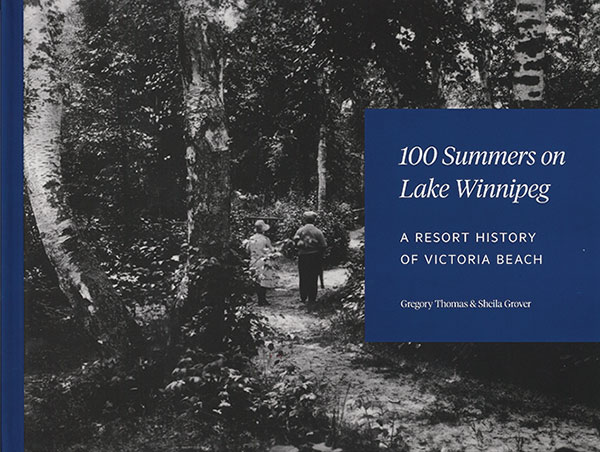by C. J. “Jim” Taylor
Ottawa
|
 Gregory Thomas and Sheila Grover, 100 Summers on Lake Winnipeg: A Resort History of Victoria Beach. Winnipeg: published by the authors, 2014, 197 pages. ISBN 978-0-9936487-0-0, $50.00 (hardcover)
Gregory Thomas and Sheila Grover, 100 Summers on Lake Winnipeg: A Resort History of Victoria Beach. Winnipeg: published by the authors, 2014, 197 pages. ISBN 978-0-9936487-0-0, $50.00 (hardcover)
Victoria Beach is a cottage community some 115 kilometers north of the city Winnipeg, on the shores of Lake Winnipeg. It is laid out as a townsite, with privately-owned lots but public access to its sandy beaches. Visitors to VB, whether renters or owners, have access to club-like facilities—tennis courts, a golf course, and community functions such as dances and films—as well as parks and playing fields. As a type of resort community, it sits between cottage areas such as the private, self-contained properties found along Lake of the Woods and a more commercial, public place like Winnipeg Beach. Victoria Beach has three main components: the original cottage area, known as the restricted area, where vehicle traffic is largely prohibited during the summer months; a newer cottage area, where automobiles are allowed; and an area of year-round residences. While acknowledging the larger reality of VB, the book’s focus is the restricted cottage area.
The old cottage community is a distinctive cultural landscape, embodying ideals of some bygone rustic village, with leafy lanes winding past unmanicured cottage properties, a village green, and a restaurant and stores that also seem rooted in the past. Restricting the area to nonmotorized traffic during the summer months contributes to its distinctive ambience. A large parking lot is situated at the entrance where, during the summer months, visitors leave their car and proceed to their cottages by foot, bicycle, or taxi. From the beginnings of the community following the incorporation of the Victoria Beach Investment Company in 1911, through to its present incarnation as part of the municipality of Victoria Beach, there has been a remarkable continuity of vision as to how this cultural landscape should be conserved.
A good example of this continuity of vision is the authors’ summary of the community’s position in the 1940s when faced with the introduction of roads and electrical service to VB. The cottage community remained intent that the roads and avenues should retain the same ‘rustic simplicity’ that the pioneer cottagers experienced when the first train arrived in 1916: “Key to the preservation of the landscape was the strict control of the native vegetation along the avenues, the maintenance of the inside paths for pedestrians, the absence of electrical power poles and the ongoing ban on cars beyond taxis and service vehicles” (p. 117).
Intertwined with this strong sense of place is a strong community spirit, with inherited traditions, outlook and memories. Annual events include a sports day, children’s masquerade, garden competition, and tennis tournament. Contributing to this sense of tradition is the continuity of ownership, with sons and daughters inheriting cottages that they spent their childhood summers in, while in turn passing them along to their children.
Long-time cottage owners at VB, the husband and wife team of Sheila Grover and Greg Thomas attempt to come to grips with this community and its particular identity, or, as they call it: “A place of the heart” (p. 185). They have produced a book that is part history and part meditation on the VB experience, writing with both knowledge of, and passion for, their subject. Much of the history focusses on the theme of building and preserving a distinct communal environment, detailing many events and personalities along the way. In this, the authors made good use of municipal records, as well as the seasonal newspaper: the Victoria Beach Herald. The book also incorporates much personal knowledge, often within the many sidebars, which offer comments on such topics as sand castles, gardens, berry picking, bicycles, and cottage reading. The chapter titled, “The Cottage Experience: Early Years and Beyond,” skillfully blends documentary research with this personal knowledge.
Although privately published, the book is attractively laid out; its landscape format and glossy pages showing the many photographs that illustrate the pages to good effect. Sidebars and sub-headings make it easier for the casual reader to dip into the book, idly skimming the pages as he or she lazes away a summer afternoon waiting for cocktails and barbecue to follow. The book does suffer from some of the shortcomings of a self-published venture. It would have benefited from some detached editing, removing some undisciplined prose, tightening up the sub-sections, and expanding areas that could use more explanation for those not intimately familiar with VB. I would have liked to have seen some better maps, for example, that explain the spatial relationship between the cottage area, beaches, and public areas. As a social history, there is not much information about property succession; as architectural history, few examples of cottage styles. Despite these shortcomings, the book will undoubtedly find its way to the bookshelves of many VB cottages, finding company with Peterson Field Guides, paperback mysteries, and crossword puzzle dictionaries.
Page revised: 19 November 2015